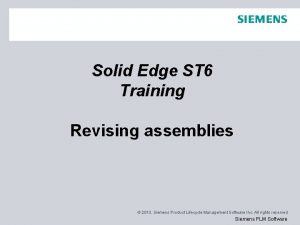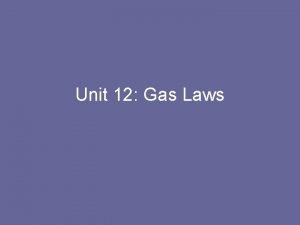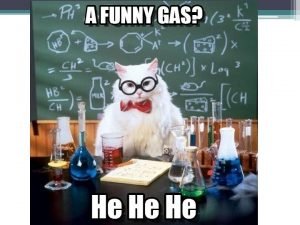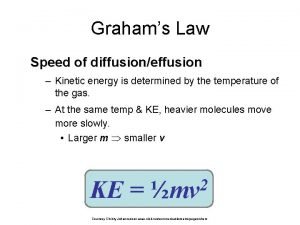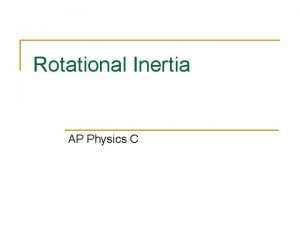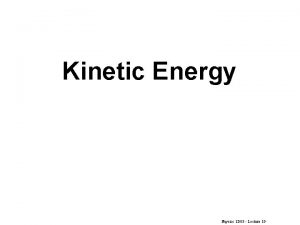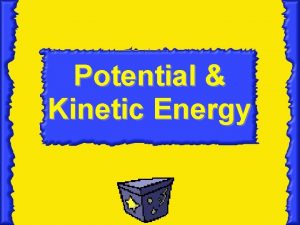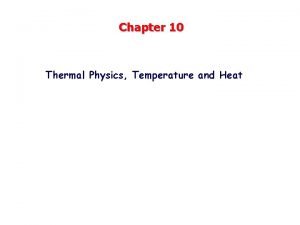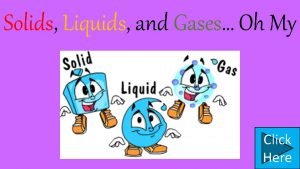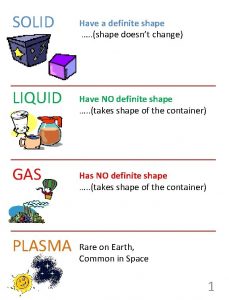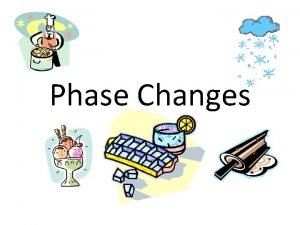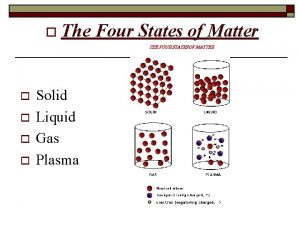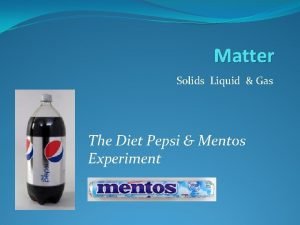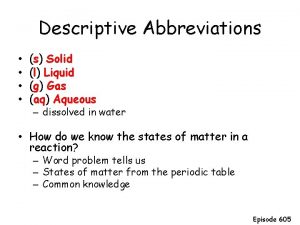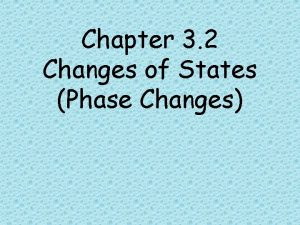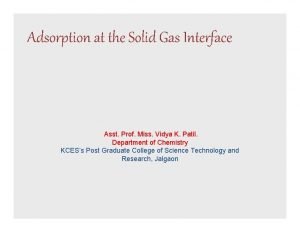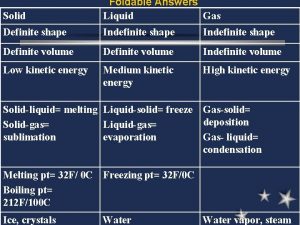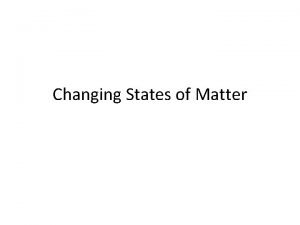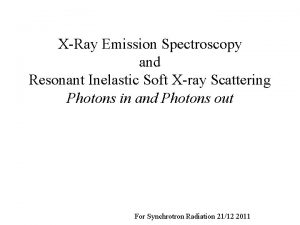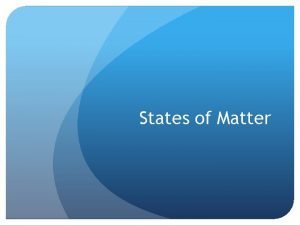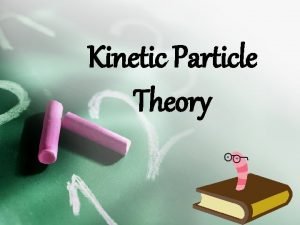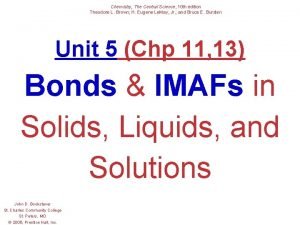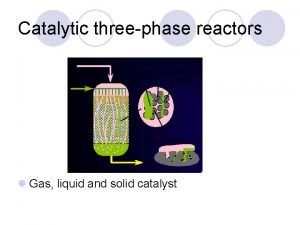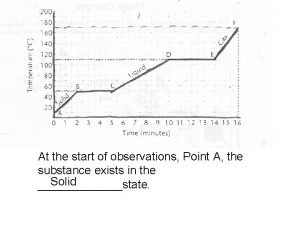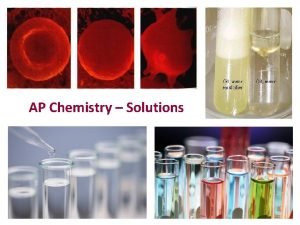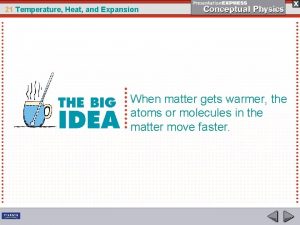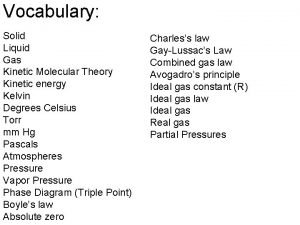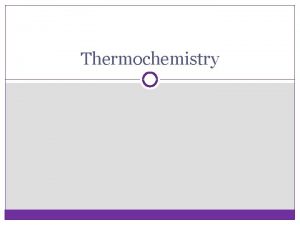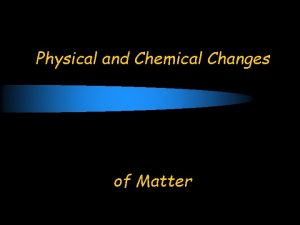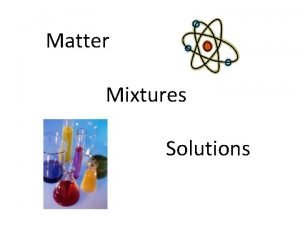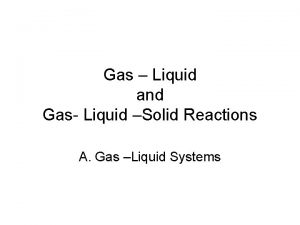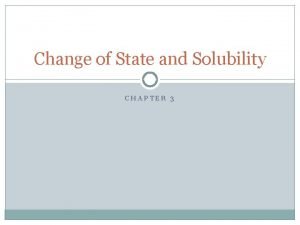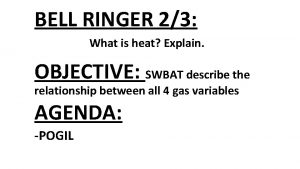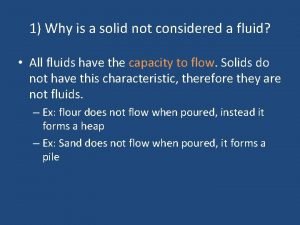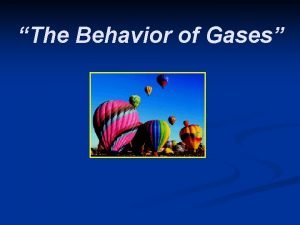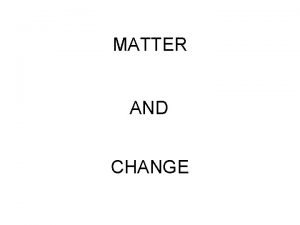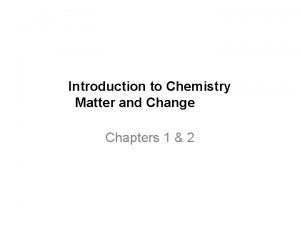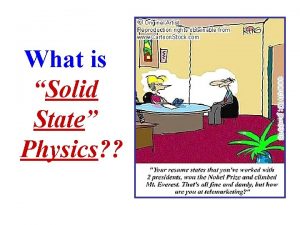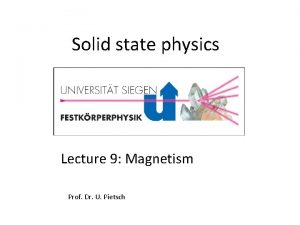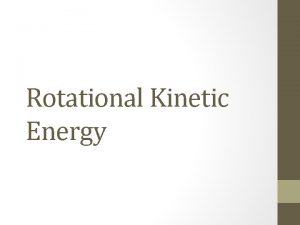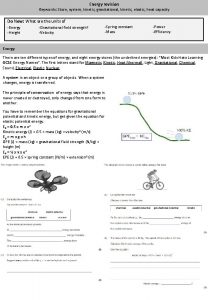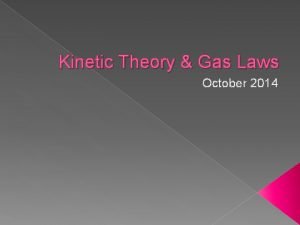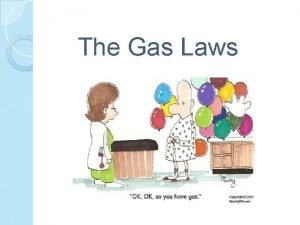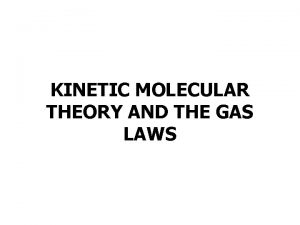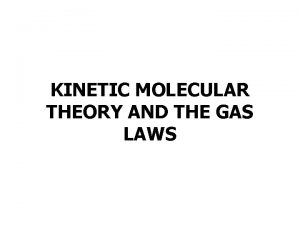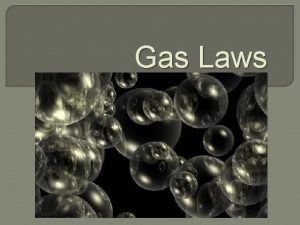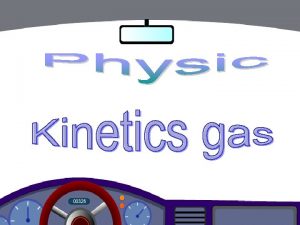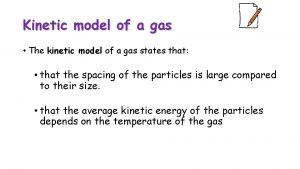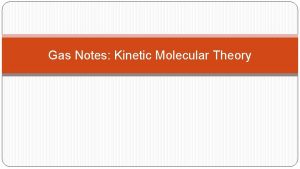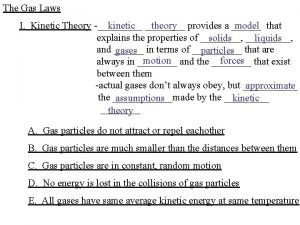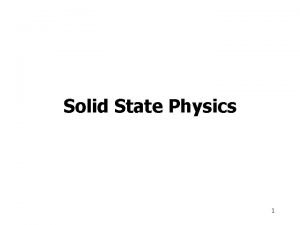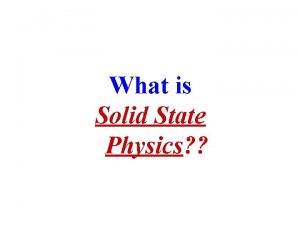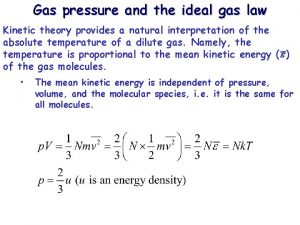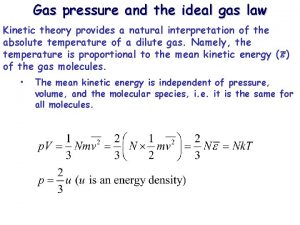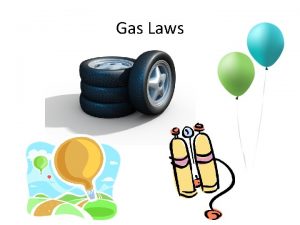Physics P 1 revision solid gas solid KINETIC



































































- Slides: 67

Physics P 1 revision

solid gas solid KINETIC PARTICLE THEORY Past paper question

1. The marbles model act as molecules / atoms 2. Molecules leaving a liquid = evaporation OR marbles leaving tray = evaporation KINETIC PARTICLE THEORY Past paper question

1. To evaporate the alcohol requires energy 2. This energy (heat) is taken from the skin and the skin feels cold KINETIC PARTICLE THEORY Past paper question

TRANSFER OF ENERGY Heat Energy Transfer

1. 2. 3. 4. Metals are good conductors Non-metals and gases are poor conductors Insulators are poor conductors Free electrons are able to move about in metals and the part of the metal atoms that are left behind are charged metal ions 5. These metal ions are packed closely together and vibrate all the time 6. The hotter the metal, the faster the vibrations of the ions 7. This kinetic energy is then transferred from the hotter parts of the metal to the cooler parts of the metal by the free electrons as they collide with the ions as they move about TRANSFER OF ENERGY Conduction – key facts

1. Liquids and gases are fluids 2. When fluids are heated, they expand as the particles move faster and further apart 3. The liquid or gas then becomes less dense as the particles take up more space but the particles are still the same size 4. The liquid or gas in hot areas is less dense than the liquid or gas in cold areas, so it rises into the cold areas. 5. The denser cold liquid or gas falls into the warm areas. 6. This cycle continues until the heat source is removed 7. The wind is caused by convection currents from the Earth being heated by the sun TRANSFER OF ENERGY Convection – key facts

Emitting IR radiation All objects emit (give out) some thermal radiation, hotter object give out more IR. The greater the temperature difference the greater the rate of transfer. Certain surfaces are better at emitting (giving out) IR radiation than others. The greater the surface area the greater the rate of transfer. worst emitter best emitter matt black white silver Matt black surfaces are the best emitters and absorbers of radiation. Shiny surfaces are the worst emitters and absorbers of radiation.

1. The particles in a liquid have different amounts of kinetic energy. 2. Some will have enough energy to escape from the liquid at the surface and become a gas. 3. The remaining particles in the liquid have a lower average kinetic energy than before, so the liquid cools down as evaporation happens. 4. This is why sweating cools you down. 5. The sweat absorbs energy from your skin so that it can continue to evaporate. TRANSFER OF ENERGY Evaporation – key facts

1. The particles in a gas have amounts of kinetic energy. Some may not have enough energy to remain as separate particles, particularly if the gas is cooled down. . TRANSFER OF ENERGY Condensation – key facts

1. Condensation happens faster if the temperature of the gas is lowered 2. Evaporation happens faster if the temperature of the liquid is increased. 3. Evaporation happens faster if the surface area is increased 4. Evaporation happens faster if air is moving over the surface of the liquid TRANSFER OF ENERGY Factors affecting condensation and evaporation – key facts

U Values High U value = bad insulator Low U value = good insulator Single glazed window Double glazed window Brick wall Insulated brick wall 2. 0 1. 5 1. 2 0. 3

Payback time is the time to ‘get your money back’. payback time (in years) = cost of insulation saving each year Example: Adding silver reflectors behind radiators costs £ 25 and saves £ 50 per year. payback time = 25 50 = 0. 5 years = 6 months

Energy changes To describe an energy change for a light bulb we need to do 3 steps: 1) Write down the starting energy: 2) Draw an arrow Electricity 3) Write down what energy types are given out: Light + Heat

Most Kids Hate Learning GCSE Energy Names • • • Magnetic Kinetic (movement energy) Heat (thermal energy) Light Gravitational potential Chemical Sound Electrical Elastic potential Nuclear ENERGY EFFICIENCY Energy efficiency

Wasted Input Useful ENERGY EFFICIENCY Energy efficiency

Wasted Input Useful ENERGY EFFICIENCY Energy efficiency

Wasted Input Useful ENERGY EFFICIENCY Energy efficiency

The thickness of each arrow is drawn to scale to show the amount of energy ENERGY EFFICIENCY Sankey Diagram

Efficiency is defined as Efficiency (%) = useful energy output x 100 total energy input • The closer the efficiency is to 1 or 100%, the more efficient the device is and the less energy it wastes • No device will have an efficiency of 1 or 100% as some energy is always lost as heat and warms up the surroundings ENERGY EFFICIENCY Efficiency

1. 120 / 200 = 2. 0. 6 or 60% ENERGY EFFICIENCY Past paper question

ENERGY EFFICIENCY 1. Most energy out as light or least energy wasted as heat

20 squares 14 squares 1. Useful / input 2. 6 / 20 = 0. 3 or 30% GENERATING ELECTRICITY 6 squares

What is specific heat capacity? The specific heat capacity of a material is the amount of energy required to raise 1 kg of the material by 1 °C. It can be used to work out how much energy is needed to raise the temperature of a material by a certain amount: energy = mass × E = m x specific heat temperature × capacity change c x θ l Energy is measured in joules (J). l Mass is measured in kilograms (kg). l Temperature change is measured in °C. l Specific heat capacity is measured in J/kg°C.

All of these methods are used to heat water to create steam which is used to turn the turbine and generate electricity Energy source Coal Advantages Disadvantages Relatively cheap to mine, Non-renewable, ready made fuels burning produces CO 2 Oil Short start-up time, ready made fuels Gas Slightly cleaner fuel than oil Non-renewable, and gas and is a ready made burning produces CO 2 fuel Nuclear power Produces lots of energy, does not produce CO 2 Non-renewable, burning produces CO 2 Non-renewable, produces dangerous nuclear waste GENERATING ELECTRICITY Non-Renewable energy

1. Wind, hydroelectricity and geothermal all turn a turbine which will create electricity 2. Solar cells use light to create electricity Energy source Advantages Disadvantages Wind Renewable, no fuel costs No wind sometimes (unreliable), noisy Hydroelectric Renewable, no fuel costs Can flood areas, disrupts habitats Solar Renewable, no fuel costs No sun at night, some countries don’t get enough sun in the day Geothermal Renewable, no fuel costs Only available in volcanic regions, GENERATING ELECTRICITY Renewable energy

Transformers and the supply chain


GENERATING ELECTRICITY Generator Boiler

• • • E = P × t E - energy transferred in k. Wh P - power in k. W t - time in h. Power is sometimes given in W. To convert from W to k. W you must divide by 1, 000. • E. g. 2, 000 W = 2, 000 ÷ 1, 000 = 2 k. W. COST OF ELECTRICITY Cost of electricity

ENERGY EFFICIENCY 1. 2. 3. 4. Energy = power × time Power = 0. 85 k. W, time = 0. 1 Energy = 0. 085 k. Wh

total cost = number of units × cost per unit • E. g. if 5 units of electricity are used at a cost of 8 p per unit, the total cost will be 5 × 8 = 40 p • The number of units used can be calculated using this equation: total cost = power (k. W) × time (h) × cost per unit COST OF ELECTRICITY • Electricity meters measure the number of units of electricity used. The more units used, the greater the cost.

• Waves are vibrations that transfer energy from place to place without matter (solid, liquid or gas) being transferred. • Some waves must travel through a substance. The substance is known as the medium and it can be solid, liquid or gas. WAVES P 1 b Waves

• In transverse waves, the oscillations (vibrations) are at right angles to the direction of travel and energy transfer • Light and other types of electromagnetic radiation are transverse waves. All types of electromagnetic waves travel at the same speed through a vacuum, such as through space. WAVES TRANSVERSE waves

• In longitudinal waves, the oscillations are along the same direction as the direction of travel and energy transfer. • Sound waves and waves in a stretched spring are longitudinal waves. • Mechanical Waves (like a slinky spring) can be either transverse or longitudinal. WAVES Longitudinal waves

• The wavelength of a wave is the distance between a point on one wave and the same point on the next wave. • The frequency of a wave is the number of waves produced by a source each second. It is also the number of waves that pass a certain point each second. Measured in Hz WAVES Labelling waves

• The speed of a wave is related to its frequency and wavelength, according to this equation: v=f×λ • v is the wave speed in metres per second, m/s • f is the frequency in hertz, Hz • λ (lambda) is the wavelength in metres, m. WAVES Wave equation

1. speed = frequency × wavelength 1. 300, 000 / 909 000 2. = 330 m WAVES Past paper question

A 1. 0. 1 m X 2 Hz 2. 0. 2 m/s WAVES W W

The angle of incidence equals the angle of reflection • Sound waves and light waves reflect from surfaces. • Smooth surfaces produce strong echoes when sound waves hit them, and they can act as mirrors when light waves hit them. The waves are reflected uniformly and light can form images WAVES reflection

object image 1. Virtual 2. Upright 3. Laterally inverted

• Sound waves and light waves change speed when they pass across substances with different densities. • This causes them to change direction and this effect is called refraction. • Refraction doesn't happen if the waves cross the boundary at an angle of 90°(the normal) - they carry straight on. WAVES refraction

• When waves meet a gap in a barrier, they carry on through the gap and spread out • How much they spread out depends on how the width of the gap compares to the wavelength of the waves. • Lots of diffraction happens when the wavelength is the same size as the gap. WAVES diffraction

WAVES Past paper question The normal v light has moved from glass to air / from air to glass

WAVES value of v doubles but the value of y does not double

WAVES value of v doubles but the value of y does not double

WAVES As (angle) v increases, angle y increases no evidence outside this range

• • Longitudinal waves Echoes are reflections of sound waves Sound can only travel in a solid, liquid or gas A loud sound has a large amplitude A quiet sound has a small amplitude A high pitched sound has a high frequency A low pitched sound has a low frequency The normal range of human hearing is between about 20 Hz and 20 k. Hz • The range becomes less as we get older. • Sounds with frequencies above about 20 k. Hz are called ultrasound. WAVES Sound

WAVES Past paper question Microphone Loud speaker Radio waves Electrical vibrations Light waves

It will go quieter WAVES Past paper question

• Longest wavelength Lowest frequency Shortest wavelength Highest frequency WAVES ELECTROMAGNETIC (em) SPECTRUM

• Used for TV and radio • TVs use higher frequencies than radios • Diffraction allows radio signals to be received behind hills and repeater stations are used to improve reception WAVES radiowaves

• Used to transmit signals such as mobile phone calls. • Microwave transmitters and receivers on buildings and masts communicate with the mobile telephones in their range. Some mobile phones may be a health risk. Others think that the intensity of the microwaves is too low to damage tissues by heating, and microwaves are not ionising. Some wavelengths can be used to transmit information to and from satellites in orbit. Satellite TV signals use microwaves. WAVES microwaves

VISIBLE LIGHT • Visible light helps us to communicate via sight • Cameras and video recorders use visible light • Very bright light damages our eyes INFRARED Infrared is used in toasters, heaters and grills and can cause burns Used in burglar alarms, remote controls and security alarms WAVES VISIBLE LIGHT AND INFRARED

to compare mobile phone usage between the two groups enough data to indicate relationship or reduce effect of anomalous data WAVES Past paper question

WAVES Past paper question

1. Research may be biased (in favour of companies) 2. Negative effects on health may not get published 1. It allows people to easily identify lower risk phones 2. And this allows people to make a more informed choice WAVES Past paper question

• Theory – an idea but not a fact • The theory states that originally all the matter in the universe was concentrated into a single incredibly tiny point. • This began to enlarge rapidly in a hot explosion (called the Big Bang), and it is still expanding today. • The Big Bang happened about 13. 7 billion years ago ORIGINS OF THE UNIVERSE The big bang

• Cosmic microwave background radiation (CMBR) – thought to be left over heat from the original explosion • Red-shift ORIGINS OF THE UNIVERSE Evidence for the big bang

• When a police car goes past, its siren is high-pitched as it comes towards you, then becomes low-pitched as it goes away. • When a source (e. g. galaxy) moves towards an observer, the observed wavelength decreases and the frequency increases. • When a source (e. g. galaxy) moves away from an observer, the observed wavelength increases and the frequency decreases. ORIGINS OF THE UNIVERSE Explaining the Doppler effect

• When an object (e. g. galaxy) moves away from an observer, its light is affected by the Doppler effect • We know our sun has helium in it because there are black lines in the spectrum of the light from the Sun where helium has absorbed light. These lines form the absorption spectrum for helium. • When we look at the spectrum of a distant star, we still see an absorption spectrum. However, the pattern of lines has moved towards the red end of the spectrum, as you can see above. ORIGINS OF THE UNIVERSE Red-shift

• The positions of the lines have changed because of the Doppler effect. Their wavelengths have increased and their frequencies have decreased. • The further from us a star is, the more its light is redshifted. This tells us that distant galaxies are moving away from us, and that the further away a galaxy is, the faster it's moving away. • Red shift tells us how far away a galaxy is and the speed at which it is getting further away from us ORIGINS OF THE UNIVERSE Red-shift

More Evidence for the Big Bang Red shift is not the only evidence for the Big Bang. Another key piece of evidence for the Big Bang theory is cosmic microwave background radiation (CMB). CMB is electromagnetic radiation that fills the whole of the Universe and comes from every direction. It is the left over heat from the Big Bang. The expansion of the universe has stretched the waves so they are now microwaves. NASA’s COBE satellite, launched in 1989, provided vital evidence for the Big Bang theory by measuring CMB. Stephen Hawking said this picture ‘shows the mind of God’

1. Distance from Earth 2. Speed stars / galaxies are moving (away from Earth) 3. Supports theory that the Universe is expanding / Big Bang theory ORIGINS OF THE UNIVERSE Past paper question

1. The microwave radiation comes from radiation present just after Big Bang 2. The Big Bang theory is currently the only way of explaining CMBR 1. wavelength is decreased and frequency increased ORIGINS OF THE UNIVERSE Past paper question

1. Wavelength of light increases / frequency of light decreases 2. or wavelength / light moves to red end of spectrum ORIGINS OF THE UNIVERSE 1. Big bang theory – universe started at one point then expanded 2. Steady state theory – universe has no origin / has always existed

1. to find evidence to support one or both theories or to find evidence to disprove one or both theories 1. Religious belief or no / insufficient evidence ORIGINS OF THE UNIVERSE 1. Red-shift is evidence / supports idea of expanding universe 2. Both theories use the idea / accept / explain why the universe is expanding
 Revision passive
Revision passive Solid edge revision manager
Solid edge revision manager Relation between pressure and kinetic energy of gas
Relation between pressure and kinetic energy of gas Kinetic theory of gases postulates
Kinetic theory of gases postulates Kinetic energy of gas formula
Kinetic energy of gas formula Grahams law
Grahams law Rotational inertia ap physics c
Rotational inertia ap physics c Definition of kinetic energy in physics
Definition of kinetic energy in physics Example of mechanical energy
Example of mechanical energy Physics classroom kinetic energy
Physics classroom kinetic energy Chapter 14 solids liquids and gases
Chapter 14 solids liquids and gases Ideal gas vs perfect gas
Ideal gas vs perfect gas An ideal gas is an imaginary gas
An ideal gas is an imaginary gas Differences between ideal gas and real gas
Differences between ideal gas and real gas Sutherland's law
Sutherland's law Bhopal gas tragedy reason
Bhopal gas tragedy reason Gas leaked in bhopal gas tragedy
Gas leaked in bhopal gas tragedy Volume molare
Volume molare Flue gas desulfurisation gas filter
Flue gas desulfurisation gas filter Poisonous gas leaked in bhopal gas tragedy
Poisonous gas leaked in bhopal gas tragedy Difference between ideal gas and real gas
Difference between ideal gas and real gas Persamaan arrhenius
Persamaan arrhenius Gas exchange key events in gas exchange
Gas exchange key events in gas exchange Gas pressure physics
Gas pressure physics Liquid foods
Liquid foods Whats a definite shape
Whats a definite shape Molecules of solid liquid and gas
Molecules of solid liquid and gas Venn diagram solid liquid gas
Venn diagram solid liquid gas Example of deposition
Example of deposition Oo solid
Oo solid Properties of a solid
Properties of a solid Pepsi particles candy
Pepsi particles candy Liquid short form
Liquid short form Why is gas easier to compress than a liquid or a solid
Why is gas easier to compress than a liquid or a solid Combined gas law def
Combined gas law def Solid liquid gas phase change
Solid liquid gas phase change The adsorption of solid gas interface can be explained by _
The adsorption of solid gas interface can be explained by _ Is the volume of a liquid definite or indefinite
Is the volume of a liquid definite or indefinite Mixture graphic organizer
Mixture graphic organizer Phase change concept map solid liquid gas
Phase change concept map solid liquid gas State of matter concept map
State of matter concept map Gas liquid solid
Gas liquid solid Sound is
Sound is Solid liquid gas particles
Solid liquid gas particles Energy of solid, liquid and gas
Energy of solid, liquid and gas Solid liquid gas difference
Solid liquid gas difference Gas liquid solid
Gas liquid solid Gas liquid solid
Gas liquid solid Gas liquid solid
Gas liquid solid Solid liquid gas particles
Solid liquid gas particles Solid gas liquid
Solid gas liquid Solid liquid gas
Solid liquid gas States of matter
States of matter States of matter solid liquid gas
States of matter solid liquid gas Two film theory
Two film theory Solid liquid gas
Solid liquid gas Liquid solid gas
Liquid solid gas Solid liquid and gas
Solid liquid and gas Compressibility of solid liquid and gas
Compressibility of solid liquid and gas Chemistry
Chemistry State of matter
State of matter Mass of solid liquid and gas
Mass of solid liquid and gas Properties of solid liquid and gas
Properties of solid liquid and gas Why does it happen
Why does it happen University physics with modern physics fifteenth edition
University physics with modern physics fifteenth edition Physics ia example
Physics ia example Define solid state physics
Define solid state physics Magnetism in solid state physics
Magnetism in solid state physics

